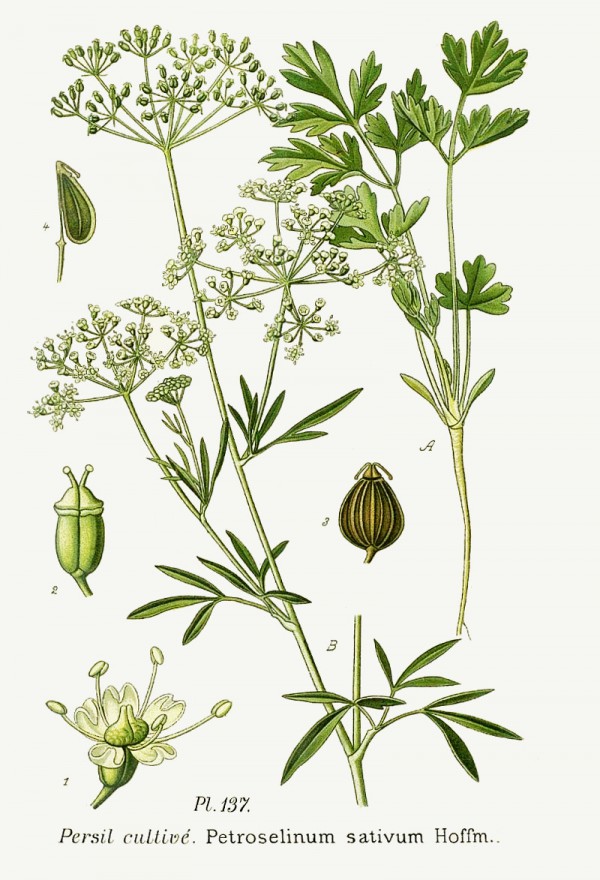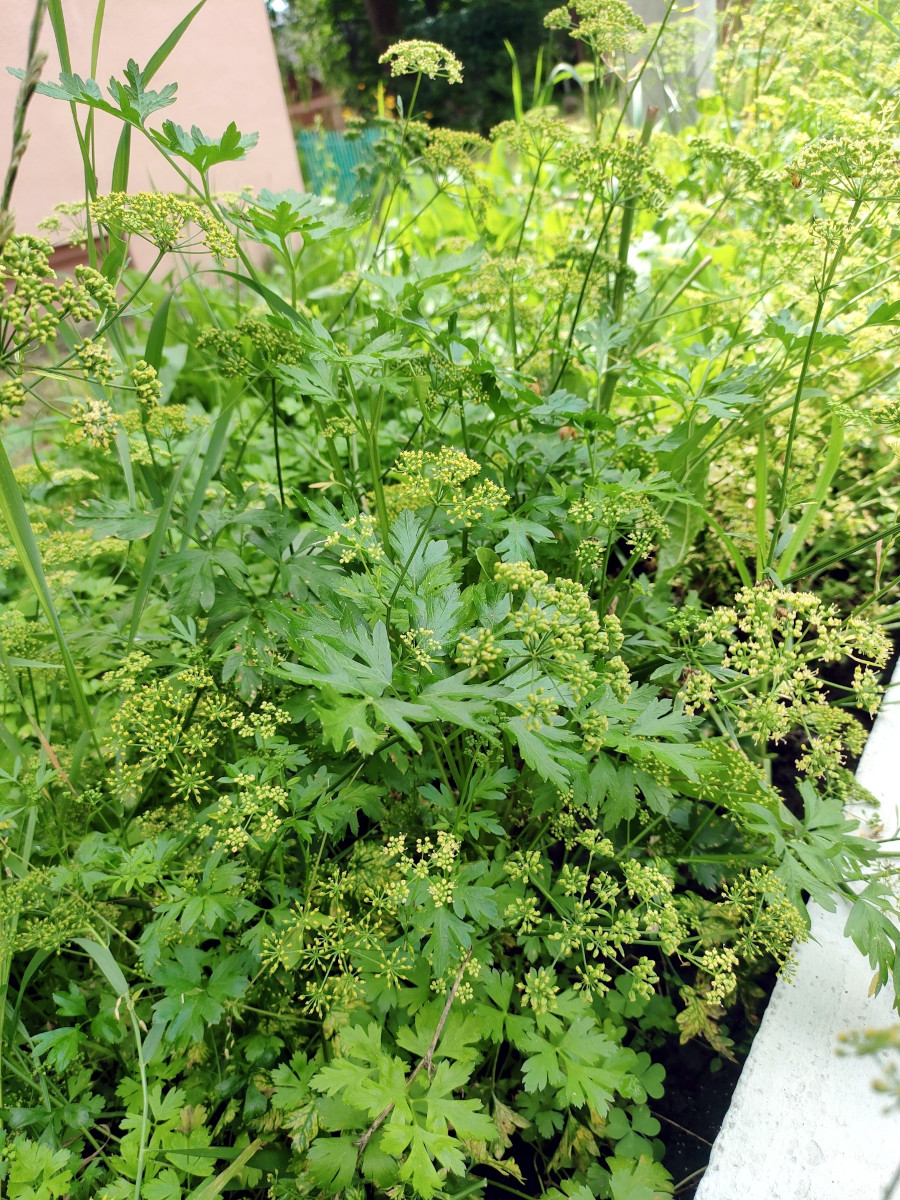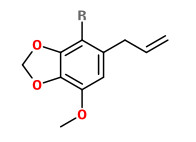Petroselinum crispum (Mill.) Fuss - syn.Petroselinum sativum Hoffm.; Apium petroselinum L.; Apium vulgare Lam.; Apium hortense E.H.L.Krause - Apiaceae - (garden) parsley, Petersilie
Annual or biennial herb, up to 70cm tall, native to the Mediterranean region, naturalized in Europe, widely cultivated;
„In cultivation, parsley is subdivided into several cultivar groups, depending on the form of the plant, which is related to its end use. Often these are treated as botanical varieties, but they are cultivated selections, not of natural botanical origin.“ wikipedia
Petroselinum crispum var. neapolitanum - Italian parsley, flat leaf parsley, Neapolitanische Petersilie, Glatte Petersilie
Petroselinum crispum var. crispum - double curled parsley, curly leaf parsley, Krause Petersilie
Petroselinum crispum var. tuberosum - root parsley, Hamburg parsley, Wurzelpetersilie
„The aroma volatiles of a desert parsley were analysed using routine procedures, and 45 constituents were positively identified, including 11 not previously reported as parsley leaf volatiles. One component, 2-(p-tolyl)propan-2-ol, is a new aroma volatile and, together with p-mentha-1,3,8-triene, may be unique to parsley. Major constituents of the sample were 4-methoxy-6-(prop-2-enyl)benzo-1,3-dioxolan (myristicin) 4,7-dimethoxy-5-(prop-2-enyl)benzo-1,3 dioxolan (apiole), β-phellandrene, p-mentha-1,3,8-triene and 4-isopropenyl-1-methylbenzene. Aroma assessments during GC showed that apiole, in particular, had desirable parsley odour character.“
[Volatile aroma constituents of parsley leaves., J MacLeod, A., H Snyder, C., Subramanian, G., Phytochemistry, Vol.24(11), 1985, 2623-2627]
„Aroma extract dilution analysis of parsley leaf volatiles resulted in 14 odour compounds having high factors of dilution. Thirteen of these compounds were identified as methyl 2-methylbutanoate, myrcene, 1-octen-3-one, (Z)-1,5-actadien-3-one, 2-isopropyl-3-methoxypyrazine, p-mentha-1,3,8-triene, linalool, 2-sec-butyl-3-methoxyprazine, (E)-6-decenal, β-citronellol, (E,E)-2,4-decadienal, β-ionone and myristicin.“
[Jung, H-P., A. Sen, and W. Grosch. „Evaluation of potent odorants in parsley leaves [Petroselinum crispum (Mill.) Nym. ssp. crispum] by aroma extract dilution analysis.“ Lebensmittel-Wissenschaft+ Technologie 25.1 (1992): 55-60]
„On the basis of dilution experiments, 17 odorants of two parsley cultivars were selected for quantification and their odour activity values (OAVs, ratio of concentration to odour threshold) were calculated. The odorants showing higher OAVs with regard to the different odour notes in the odour profile of parsley were mixed. As the aroma of this mixture was close to that of parsley, it was concluded that p-mentha-1,3,8-triene, myrcene, 2-sec-butyl-3-methoxypyrazine, myristicin, linalool, (Z)-dec-6-enal and (Z)-hex-3-enal were the character impact flavour compounds of parsley. After chopping, the aroma of parsley changed rapidly. The loss in the ‘terpeny, parsley-like’ note in the odour profile was mainly due to both a decrease of p-mentha-1,3,8-triene and an increase of the ‘green, grassy’ and ‘fruity’ notes caused by a rapid formation of (Z)-hex-3-enal, (Z)-hex-3-enol and (Z)-hex-3-enyl acetate.“
[Key odorants of parsley leaves (Petroselinum crispum [Mill.] Nym. ssp. crispum) by Odour–activity values., Masanetz, C., Grosch, W., Flavour and fragrance journal, 13(2), 1998, 115-124]
3-Methyl-2,4-nonanedione (which smells like straw) was mainly responsible for the hay-like off-flavour of parsley during drying and storage. „Two furanoid fatty acids, known to be precursors of 3-methyl-2,4-nonanedione, were detected in dry parsley. The decrease in the intensities of the parsley-like, metallic and green notes in the odour profile during storage of dry parsley was due to losses of p-mentha-1,3,8-triene, myrcene and (Z)-6-decenal. Sulphurous cabbage-like and malty notes were caused by dimethyl sulphide, methylpropanal as well as 2- and 3-methylbutanal.“
[Masanetz, C., and W. Grosch. „Hay-like off-flavour of dry parsley.“ Zeitschrift für Lebensmitteluntersuchung und-Forschung A 206.2 (1998): 114-120]
„The major components of the essential oils of the leaves of the plain leaf type harvested at both growth
stages were β-phellandrene and 1,3,8-p-menthatriene, with α-p-dimethylstyrene also forming a significant
constituent at the first stage. The two sowing dates differed with respect to the concentrations of
β-phellandrene, 1,3,8-p-menthatriene and myristicin at both growth stages, as well as apiole at the second
stage.
The essential oils of the leaves of the curly leaf type were composed mostly of β-phellandrene and myristicin, followed by 1,3,8-p-menthatriene (first stage), and myristicin and β-phellandrene (second stage of both sowings), followed by apiole, β-myrcene and α-p-dimethylstyrene (second stage of the second sowing). β-Elemene was detected only in curly leaf type, in leaves and petioles as well as in roots.
… the essential oils profile of the roots of turnip-rooted parsley was quite different from that of the leaves and petioles and varied according to the sowing date and stage of sampling. Apiole formed a major constituent at both growth stages of both sowings. However, β-pinene, β-phellandrene and myristicin, which formed important constituents of the roots at both harvest stages of the first sowing, were either absent or of minor importance in roots of the second sowing. Roots of the second sowing showed major differences in composition between the two harvest stages. Thus α-pinene, β-myrcene and myristicin, which were important constituents of the first growth stage, were not detected in the second stage, whereas 1,3,8-p-menthatriene, present in the second stage, was not detected in the first stage.“
[The effect of sowing date and growth stage on the essential oil composition of three types of parsley (Petroselinum crispum)., Petropoulos, S. A., Daferera, D., Akoumianakis, C. A., Passam, H. C., Polissiou, M. G., Journal of the Science of Food and Agriculture, Vol.84(12), 2004, 1606-1610]
„Sixteen different genotypes of parsley, including two cultivars, six populations, and eight inbred lines, were investigated regarding their sensory characteristics in relation to the volatile patterns and resistance to Septoria petroselini. The sensory quality was determined by a combination of profile analysis and preference test, whereas the volatile patterns were analyzed by headspace-SPME-GC of leaf homogenates with subsequent nontargeted data processing to prevent a possible overlooking of volatile compounds. The more resistant genotypes are characterized by several negative sensory characteristics such as bitter, grassy, herbaceous, pungent, chemical, and harsh. In contrast, the contents of some volatile compounds correlate highly and significantly either with resistance (e.g., hexanal and α-copaene) or with susceptibility (e.g., p-menthenol). Some of these compounds with very strong correlation to resistance are still unidentified and are presumed to act as resistance markers.“
[Sensory characteristics and volatile profiles of parsley (Petroselinum crispum [Mill.] Nym.) in correlation to resistance properties against Septoria blight (Septoria petroselini)., Ulrich, D., Bruchmüller, T., Krüger, H., Marthe, F., Journal of agricultural and food chemistry, Vol.59(19), 2011, 10651-10656]

Masclef,A., Atlas des plantes de France, vol.2, t.137 (1890)
http://plantgenera.org/species.php?id_species=772457

Petroselinum crispum, Kursk, Russia (2025) © mikami-kun CC BY-SA 4.0 inaturalist.org




